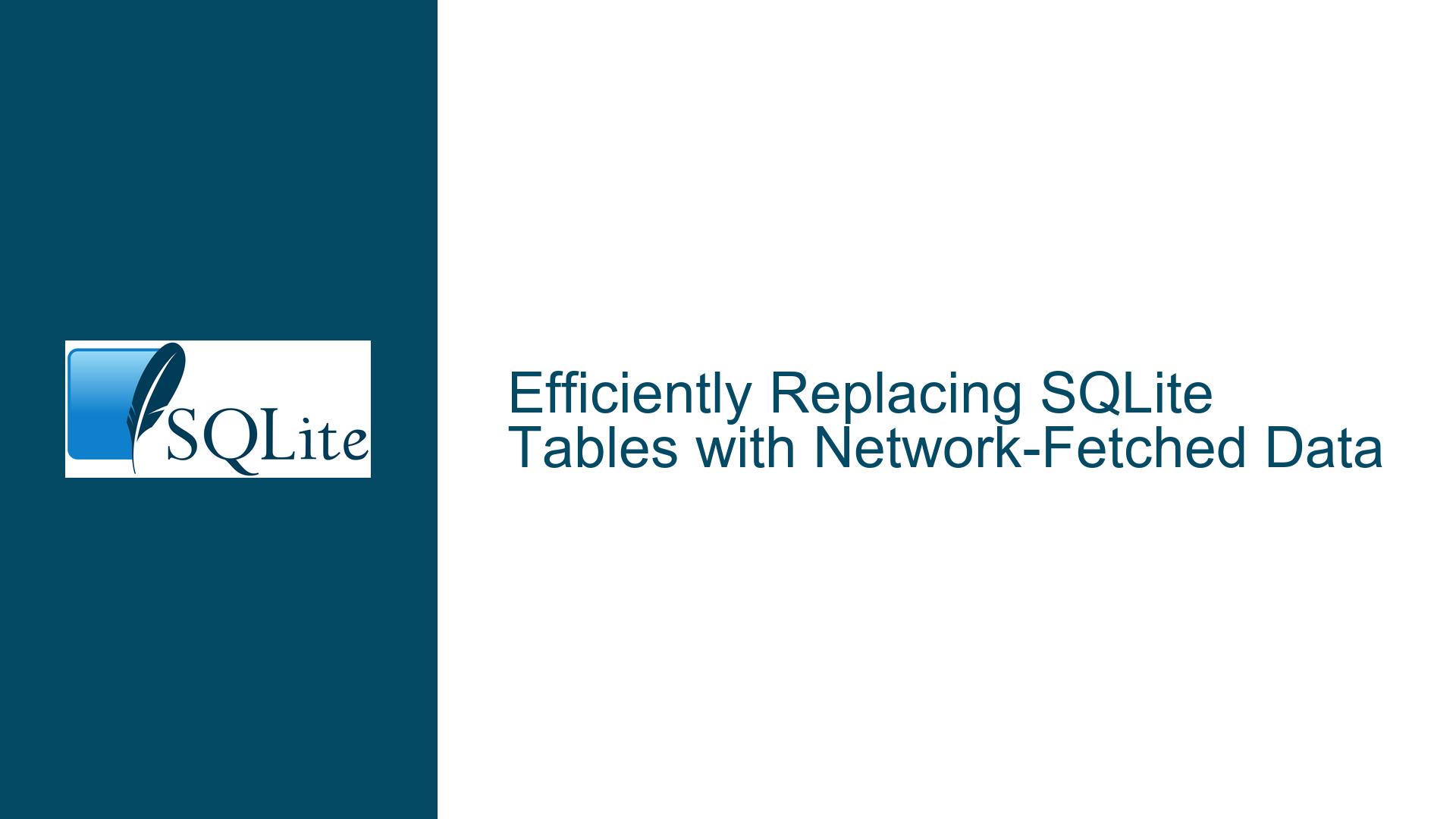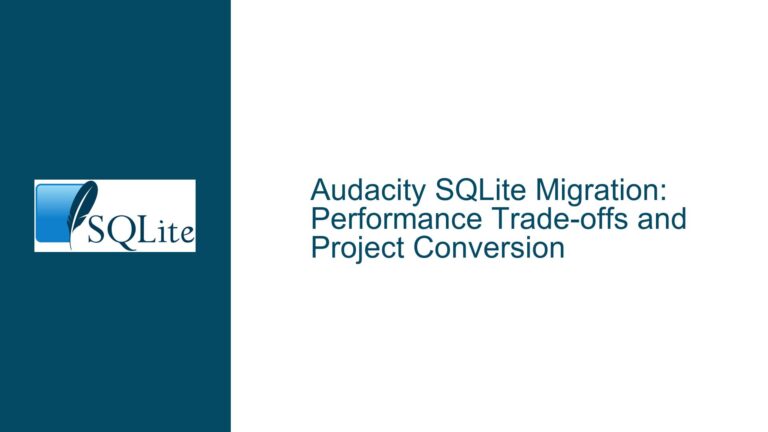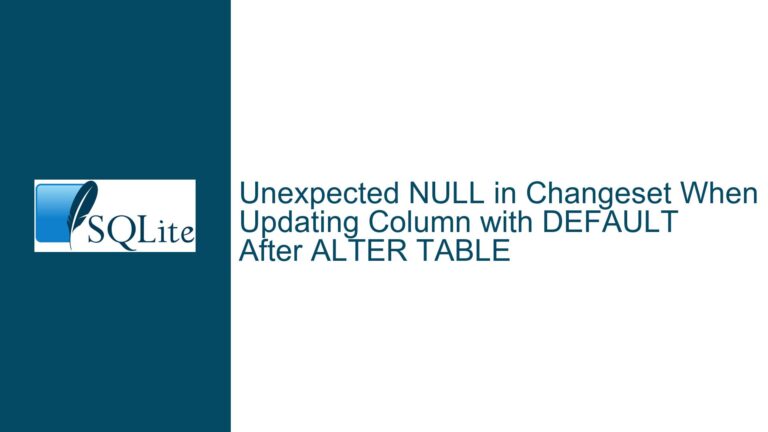Efficiently Replacing SQLite Tables with Network-Fetched Data
Understanding the Need to Replace Tables with Network-Fetched Data
In many client applications, especially those that rely on local databases like SQLite, there is often a need to update the local database with fresh data fetched from a remote server. This process typically involves downloading a new SQLite database file over the network, attaching it to the existing SQLite connection, and then replacing the contents of specific tables in the local database with the data from the fetched database. The goal is to ensure that the local database is updated with the latest data without causing disruptions or inconsistencies.
The challenge lies in performing this operation efficiently and safely. Simply dropping the existing tables and recreating them with the new data might seem straightforward, but this approach can lead to several issues, such as data inconsistency, downtime, and potential errors if the operation is interrupted. Therefore, it is crucial to adopt a more robust method that minimizes disruption and ensures data integrity throughout the process.
Potential Pitfalls in Direct Table Replacement
One of the primary concerns when replacing tables in a SQLite database is the risk of data inconsistency. If the tables are dropped and recreated without proper precautions, other connections or processes that rely on these tables might encounter errors or access incomplete data. This can lead to application crashes, data corruption, or other undesirable outcomes.
Another issue is the potential for downtime. Dropping and recreating tables can take a significant amount of time, especially if the tables contain large amounts of data. During this time, the database might be in an inconsistent state, making it inaccessible or unreliable for other operations.
Additionally, there is the risk of transaction failures. If the process of dropping and recreating tables is interrupted (e.g., due to a network issue or a system crash), the database might be left in an inconsistent state, with some tables missing or partially updated. This can be particularly problematic in applications where data integrity is critical.
Minimizing Disruption with Transactional Renaming
To address these challenges, a more sophisticated approach is needed. One effective strategy is to use transactional renaming to minimize disruption and ensure data consistency. This involves the following steps:
Attach the Fetched Database: First, the fetched SQLite database file is attached to the existing SQLite connection. This allows the local database to access the tables and data in the fetched database.
Create Temporary Tables: Instead of directly dropping the existing tables, new tables are created in the local database with temporary names. These tables are populated with the data from the fetched database.
Start a Transaction: A transaction is initiated to ensure that the subsequent operations are atomic. This means that either all the operations within the transaction are completed successfully, or none of them are applied.
Drop Existing Tables: Within the transaction, the existing tables in the local database are dropped. This step removes the old data and makes room for the new tables.
Rename Temporary Tables: The temporary tables created earlier are renamed to the original table names. This step effectively replaces the old tables with the new ones.
Commit the Transaction: The transaction is committed, making the changes permanent. If any error occurs during the transaction, it can be rolled back, ensuring that the database remains in a consistent state.
By following this approach, the database remains in a consistent state throughout the process, and other connections or processes are not exposed to incomplete or inconsistent data. Additionally, the use of transactions ensures that the operation is atomic, reducing the risk of data corruption or inconsistencies in case of failures.
Detailed Steps for Safe Table Replacement
To implement the above strategy, the following detailed steps can be followed:
Attach the Fetched Database: Use the
ATTACH DATABASEstatement to attach the fetched SQLite database file to the existing SQLite connection. For example:ATTACH DATABASE 'fetched.db' AS fetched_db;This statement attaches the
fetched.dbfile as a separate database namedfetched_dbwithin the current SQLite connection.Create Temporary Tables: Create new tables in the local database with temporary names, and populate them with the data from the fetched database. For example:
CREATE TABLE local_db.temp_table1 AS SELECT * FROM fetched_db.table1; CREATE TABLE local_db.temp_table2 AS SELECT * FROM fetched_db.table2;These statements create new tables
temp_table1andtemp_table2in the local database and copy the data fromtable1andtable2in the fetched database.Start a Transaction: Begin a transaction to ensure atomicity. For example:
BEGIN TRANSACTION;This statement starts a new transaction, ensuring that all subsequent operations are part of the same atomic unit.
Drop Existing Tables: Drop the existing tables in the local database. For example:
DROP TABLE IF EXISTS local_db.table1; DROP TABLE IF EXISTS local_db.table2;These statements drop the existing
table1andtable2in the local database, making room for the new tables.Rename Temporary Tables: Rename the temporary tables to the original table names. For example:
ALTER TABLE local_db.temp_table1 RENAME TO table1; ALTER TABLE local_db.temp_table2 RENAME TO table2;These statements rename
temp_table1andtemp_table2totable1andtable2, effectively replacing the old tables with the new ones.Commit the Transaction: Commit the transaction to make the changes permanent. For example:
COMMIT;This statement commits the transaction, applying all the changes made within the transaction.
Detach the Fetched Database: Finally, detach the fetched database to clean up. For example:
DETACH DATABASE fetched_db;This statement detaches the
fetched_dbdatabase, removing it from the current SQLite connection.
Handling Errors and Rollbacks
In case of any errors during the process, it is important to handle them gracefully and ensure that the database remains in a consistent state. SQLite provides mechanisms for rolling back transactions in case of errors, which can be used to revert any changes made during the transaction.
For example, if an error occurs while dropping the existing tables or renaming the temporary tables, the transaction can be rolled back using the ROLLBACK statement:
ROLLBACK;
This statement reverts all changes made within the current transaction, ensuring that the database remains in its original state.
Optimizing Performance
To optimize the performance of the table replacement process, consider the following tips:
Index Management: Before dropping the existing tables, consider dropping any indexes on those tables. Recreating the indexes after the new tables are in place can be more efficient than maintaining them during the data transfer.
Batch Inserts: If the fetched database contains a large amount of data, consider using batch inserts to populate the temporary tables. This can be more efficient than inserting rows one by one.
Vacuuming: After the table replacement process is complete, consider running the
VACUUMcommand to optimize the database file and reclaim any unused space.
Conclusion
Replacing tables in a SQLite database with data from a network-fetched database file can be a complex operation, but with the right approach, it can be done efficiently and safely. By using transactional renaming, minimizing disruption, and handling errors gracefully, you can ensure that your database remains consistent and reliable throughout the process. Following the detailed steps outlined above will help you achieve a smooth and successful table replacement, ensuring that your application continues to function seamlessly with the latest data.






